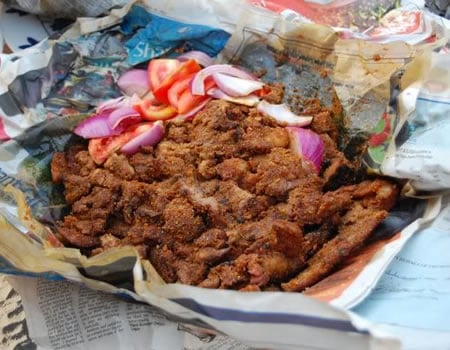By Isaac Atunlute
Across many Nigerian cities, it is still common to find street vendors serving popular snacks, such as akara, suya and roasted corn, in old newspapers.
Newspapers are inexpensive and convenient. But what about the hazards?
As a food wrapper, newspapers pose health risks because of the ink and chemicals used in print, which can leach into the food, especially when it’s oily or hot.
The Hidden Threat
Newspaper ink is not just ink; it’s a chemical cocktail of lead, aromatic hydrocarbons, and bioactive compounds. When hot, oily food comes in contact with the ink, these substances can leach into the food, causing havoc.
“Newspapers are not sterile. When they get into contact with food, especially hot food, there’s a high chance of food contamination and subsequent foodborne illness,” explains Akinwale, a public-health expert.
Rosemary Thomas, a Lagos resident who frequented suya arcades, recalls her haunting episode of stomach cramps. “I had to be hospitalised. The doctor said it was food poisoning caused by dirty packaging.”
Some countries, such as India, have banned the use of newspapers as food wrapping, describing it as “a serious health risk.”
To reduce this risk, safer, more hygienic alternatives are:
- Aluminum foil
- Wax paper
- Food-grade plastic containers
- Banana leaves (biodegradable and traditional)
These not only protect you from harmful chemicals but also reduce the risk of foodborne illness.
Conclusion
While the tradition of wrapping food in newspapers might seem nostalgic, health risks far outweigh the convenience. It is essential to opt for safer, food-grade packaging options. After all, your health is too valuable to gamble on yesterday’s headlines.
Across many Nigerian cities, street vendors commonly use old newspapers to wrap popular snacks such as akara, suya, and roasted corn due to their affordability and convenience. However, using newspapers as food wrappers poses significant health risks because the ink contains harmful chemicals, including lead and aromatic hydrocarbons, which can leach into the food, particularly when it is hot or oily.
Public health experts warn of the contamination risk from using newspapers for food packaging, which can lead to foodborne illnesses. Personal accounts, such as that of Rosemary Thomas from Lagos, highlight the severe consequences, including stomach cramps and food poisoning linked to contaminated packaging. Recognizing these dangers, some countries like India have banned newspapers for food wrapping, labeling it a serious health risk.
To mitigate these risks, safer alternatives are recommended, such as aluminum foil, wax paper, food-grade plastic containers, and biodegradable options like banana leaves. These alternatives help protect consumers from toxic chemicals and decrease the likelihood of foodborne illnesses.
In conclusion, while wrapping food in newspapers may offer nostalgia and convenience, the potential health risks are substantial. It is crucial to prioritize health by choosing safer, food-grade packaging options, as the consequences of exposure to harmful materials are too serious to overlook.






